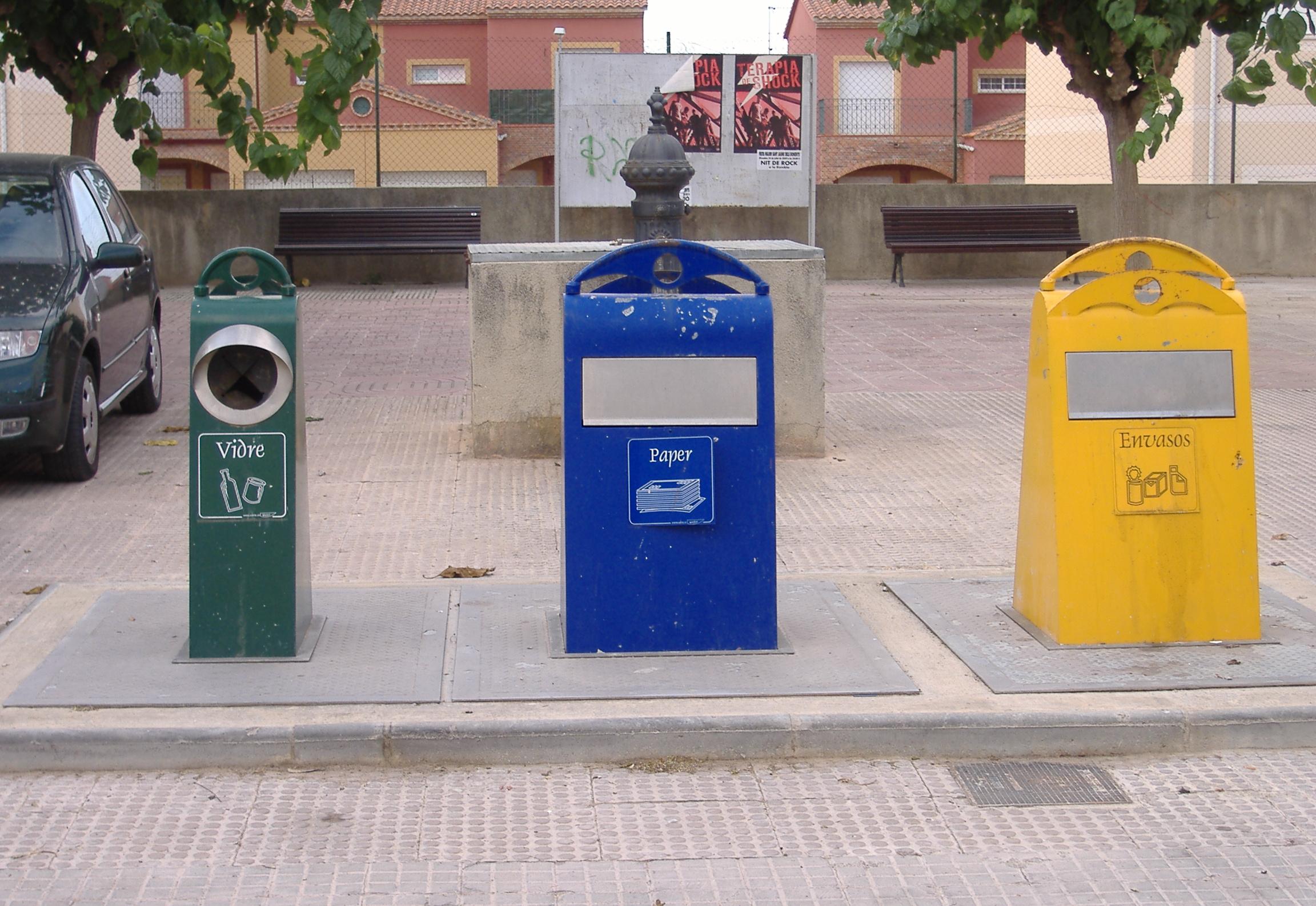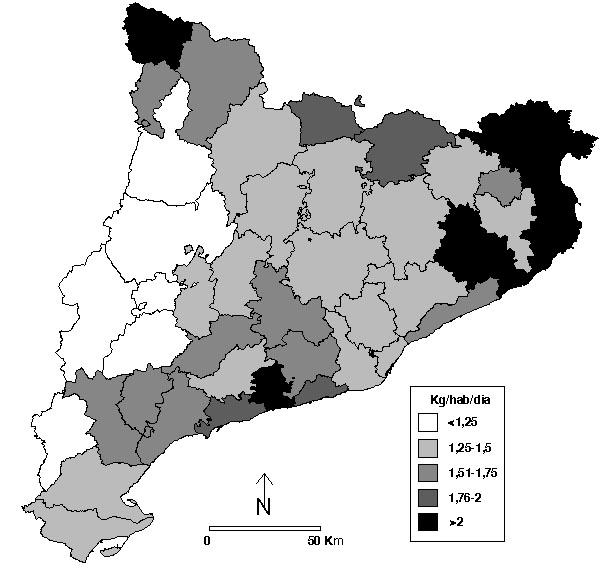DOW/URV Chair of Sustainable Development - Sustainable development notes
MUNICIPAL WASTE AND SUSTAINABLE DEVELOPMENT
TO REDUCE THE GENERATION AND TO INCREASE THE SELECTIVE COLLECTION
This article is also available in PDF version.
One of the main features of the economically developed societies is the making and the consumption of a lot of products that are intended to satisfy people needs, even if this are basic or not. Most of these products have a short lifecycle, that is, when their use is finished, they can became waste. All the human activities, including the merely biological, generate by-products that can have no value, but at the same time they can be very harmful to the human health, flora and fauna and to the whole environment. If there is no will to risk and create a serious environmental problem, it is necessary to have a right manage of all these substances that on the whole are called waste. At present, waste (or what to do with waste) is a very worrying environmental problem that different administrations try to solve.
One of the waste types is the municipal one: the waste that everybody generates, to a greater or lesser extent, independently of the living place or the economic development level of the territory. The municipal waste is the 20th group in the list of the European Waste Catalogue and they consist of domestic waste, as well as waste from commerce, industries, and institutions, including the selective collection.
In the last decades there has been a spectacular increase of their total amount. It is obvious that this is partly due to the fact that there are more and more people, but the most concerning thing is the increase of the generated amount per person. For this reason, the aim of the Waste Management Programme of Catalonia (PROGREMIC) for 2012, which was enforced in 2007, is to reduce the generated amount until 1.48 kg/inhabitant/day, and at the same time to recycle a great part of it, not to a final disposal (mostly to a refuse disposal or incineration). The last February, the presentation of the Proposal of Catalonia Strategy for Sustainable Development, 2026.Cat of the Generalitat of Catalonia, took place in Barcelona. Concerning to municipal waste, the aim for 2026 is to achieve a 1.23 kg/inhabitant/day (0.97kg from households and 0.26 kg from commerce).
REDUCE, RECYCLE and REUSE, the triple R to which the United Nation Environment Programme (UNEP) has added three more: RETHINK the products and their function, REPLACE the dangerous substances and REPAIR to prolong products life.
SUBTERRANEAN CONTAINERS FOR THE SELECTIVE WASTE COLLECTION

Photography: Òscar Saladié
Which are the generation values of municipals waste and its selective collection rates in Catalonia?
In 2008 the Catalonia average was 1.58 kg/inhabitant/day, meanwhile the selective collection reached 34.4%. The 2008 average (1.58 kg/inhabitant/day) is too far from the PROGREMIC goal and this is even more noticeable if we compare it with the 2000 average of 1.51 kg/inhabitant/day. In spite of that, for the first time in years the year on year variation has been negative, that is to say that the 2008 value is lower than the 2007 one (1.64 kg/inhabitant/day). From this point of view, there has been an improvement of the selective collection, since in 2000 it was only 17.7% but in 2008 this percentage has practically doubled. We can be sure this improvement has been possible due to the involvement of different administrations, as well as the rising civic conscientization of the need of collecting the waste selectively right from the start.
In the matter of waste generation and its selective collection, there are important differences at territorial level in Catalonia. Consequently, there are regions, Terra Alta, for instance, where 1.10 kg/inhabitant/day is generated, meanwhile there are regions as Baix Penedès, with more than 2 kg/inhabitant/day. Concluding: could Baix Penedès citizens generate more waste than those from Terra Alta? Yes, it could be. But, so much difference? Absolutely not. Tons and tons of municipal waste collected in Baix Penedès are imputed to a little more than 100.000 inhabitants that are registered in the region’s several municipalities. But the true is that the waste has been generated by a much larger number of people, including the registered citizens and also visitants, excursionists, and above all tourists that live temporarily in this region and produce wealth, but also waste they are not attributed.
GENERATION OF MUNICIPAL WASTE IN CATALONIA (2008)

Source: Own making
There are also noticeable differences between the regions’ selective collection. Ribera d’Ebre is the region that has the highest rate: 53.2%. On the contrary, in 11 regions the number is less than 25%, but there is an explanation for that. Besides the civic involvement, the collection of the organic fraction has a large influence on the final average, as it represents a more than 30% of the whole waste. In fact, until 2010 it was not compulsory for the towns with less than 5000 inhabitants to have this service. For example, the 2008 selective collection in Baix Penedès was less than 20%, but the organic fraction collective was available in only 4 municipalities, even though these contained more than 2/3 of the region population.
SELECTIVE COLLECTION OF THE MUNICIPAL WASTE IN CATALONIA (2008)

Source: Own making
There is still a lot of work to do, but we are sure that the total amount of the selectively collected waste will be increased in the following years. This improvement can be a consequence of the used collection system. One of the alternative options is the door to door collection system, which was implemented in Arboç municipality (Baix Penedès) in April 2009. Spectacular results have been obtained, as the 2008 selective collection only reached 22%, and now, thanks to the new system, 66% has been reached. For this reason we can congratulate the Arboç Town Council, specifically the Technical Services of the Environment Department, and especially the municipality residents.
It’s obvious that the door to door system cannot be implemented everywhere, but even though, it can be put into practice in more towns. In fact, some Baix Penedès municipalities, as Bisbal del Penedès or Sant Jaume dels Domenys, are starting the implementation of the new system.
The real costs of municipal waste management for the town councils would depend on the used system, but this is a different topic to talk about. Everybody should know that the town council has to pay for each waste kilogramme which goes to final disposal (a refuse disposal or incinerator). But on the contrary, the town council receive refund for each selectively collected waste kilogramme (glass, paper, cardboard, etc) that does not go to final disposal. It is clear that the generated quantity should be reduced, and, what is even more important, the most part of it should be recycled. Let’s leave this topic for another article.
It would be more difficult to achieve the expected reduction of the generation per capita than to increase the percentage of the selective collection, although it could be reached because of the current financial crisis. Unless we are going to have the 2009 data of entire Catalonia, we will be able to talk more about it.
The resource consumption, together with the territory occupation, the generation and manage of the waste are key activities for reaching our environmental integration and achieving definitely or at least getting near to a sustainable development.
Dr. Òscar Saladié
Geography Department Professor - Rovira i Virgili University
DOW/URV Chair of Sustainable Development
Translated by Ecaterina Untura,
Collaboration Grant Holder of the DOW/URV Chair of Sustainable Development



